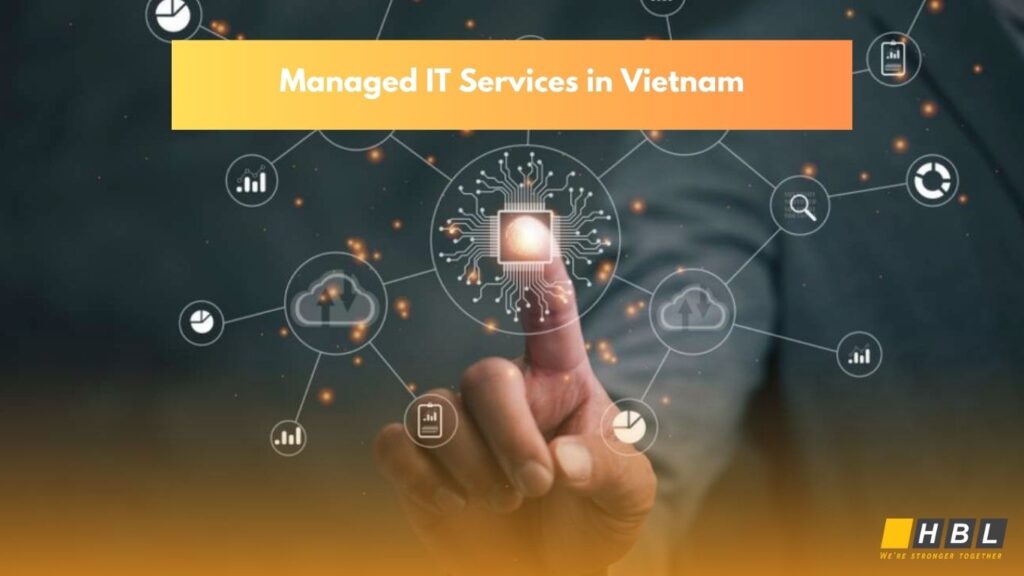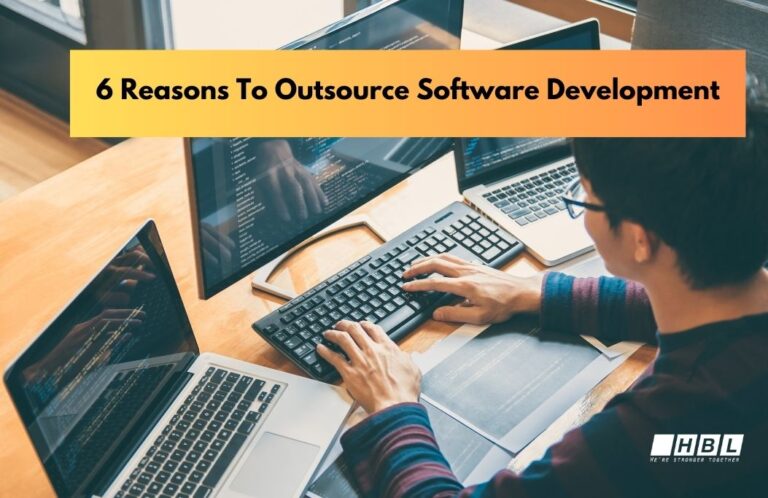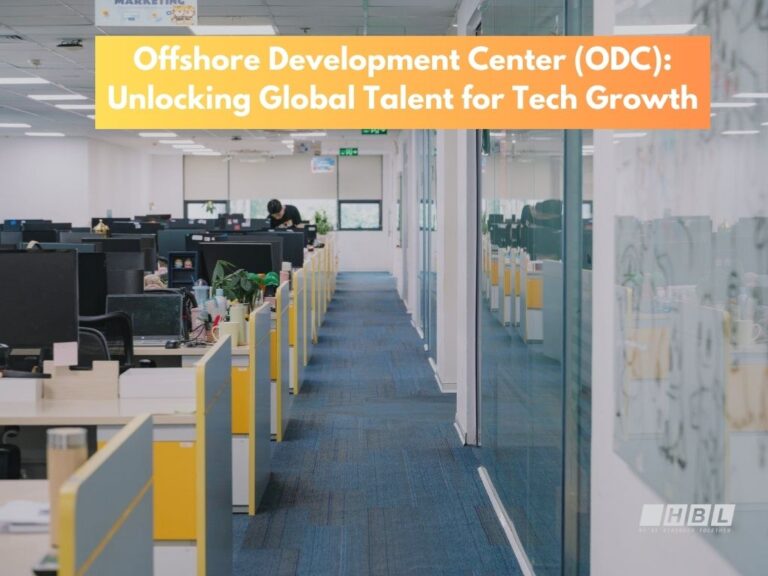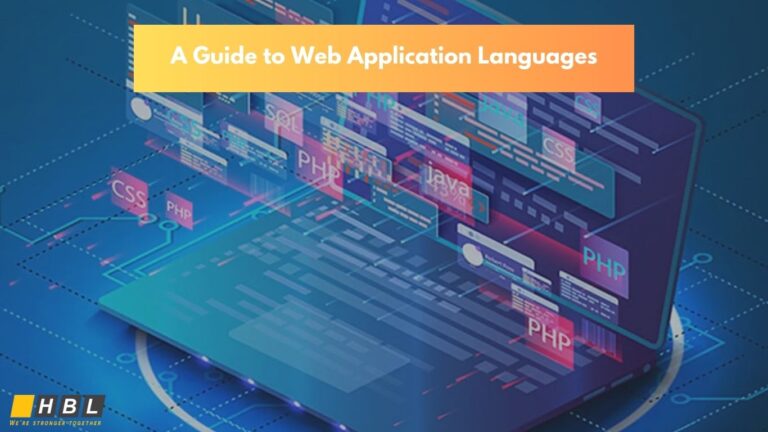This article provides an in-depth overview of Managed IT Services, their growing importance in today’s business landscape, and Vietnam’s emergence as a competitive destination for outsourcing IT functions.
Introduction to Managed IT Services
In an increasingly digital-first world, IT is no longer just a support function — it’s a strategic driver of business growth, innovation, and customer satisfaction. However, managing a full-scale IT infrastructure in-house can be costly, resource-intensive, and complex, especially for organizations facing rapid growth or operating in competitive markets.
Managed IT Services provide businesses with a strategic option to delegate some or all of their IT functions to external specialists, commonly referred to as Managed Services Providers (MSPs). These providers take responsibility for maintaining, securing, and optimizing IT environments, so that internal teams can focus on core business functions.
Typical services offered by MSPs include:
- 24/7 IT monitoring and support
- Network and infrastructure management
- Cybersecurity and threat protection
- Cloud migration and optimization
- Data backup and disaster recovery planning
- Helpdesk and end-user support
- Regulatory compliance management

Unlike the traditional break-fix IT support model, managed services are proactive, with providers constantly monitoring systems to prevent downtime and minimize risks. Most providers offer subscription-based pricing, giving businesses predictable costs and flexible service models based on their needs.
For startups, SMEs, and even enterprises in sectors like finance, healthcare, manufacturing, and retail, Managed IT Services can lead to:
- Reduced operational costs
- Improved service uptime and customer experience
- Faster adoption of emerging technologies
- Stronger cybersecurity posture
- Access to expert talent without high recruitment costs
This modern approach to IT management has gained popularity across the globe — and countries like Vietnam are emerging as prime destinations for high-quality, cost-effective managed services that meet international standards.
Key Drivers Behind the Shift to Managed IT Services
Today, the traditional in-house IT model is often no longer sufficient to support modern business needs. This is why organizations — from startups to large enterprises — are increasingly adopting Managed IT Services. The shift is driven by several key factors:
1. Digital Transformation and Innovation Pressure
Businesses are under pressure to innovate rapidly, adopt new technologies, and maintain high availability. Managed IT Services providers (MSPs) bring the infrastructure and expertise needed to support this digital transformation journey efficiently.
2. Rising Cybersecurity Threats
As cyberattacks become more sophisticated and frequent, organizations must secure their systems, networks, and data proactively. MSPs offer enterprise-grade cybersecurity tools, threat detection, firewalls, endpoint protection, and compliance assistance.
3. Global Shortage of Skilled IT Talent
Recruiting and retaining top-tier IT professionals is a challenge worldwide. By outsourcing IT services, companies gain immediate access to highly skilled engineers, developers, and cybersecurity experts without the lengthy hiring process.
4. 24/7 Monitoring and Support
With businesses expanding globally and operating across time zones, round-the-clock IT support has become essential. Managed service providers offer 24/7 monitoring and helpdesk support, ensuring uninterrupted service and quick issue resolution.

5. Cost Optimization and Predictable Budgeting
Instead of unpredictable break/fix models, managed services offer flat-rate monthly pricing, enabling better financial planning. Organizations can scale services up or down based on their actual needs.
6. Business Continuity and Disaster Recovery
Natural disasters, cyberattacks, and system failures can cause significant business disruption. MSPs provide backup and disaster recovery services that ensure data integrity and business continuity.
7. Focus on Core Business Functions
Outsourcing IT operations frees up internal resources to focus on what matters most — core competencies, product development, customer engagement, and strategic initiatives.
Benefits of Managed IT Services
The decision to adopt Managed IT Services can yield substantial returns in both the short and long term. Here’s a deeper dive into the advantages that make this model highly attractive:
1. Reduced Operational Costs
- Minimize expenses associated with hiring, training, and maintaining an internal IT team.
- Avoid capital expenditures on servers, software, and network infrastructure.
- Gain access to tools and technologies without up-front investments.
2. Access to Enterprise-Level Expertise
- Leverage the knowledge of certified professionals in cloud computing, cybersecurity, DevOps, and more.
- Stay ahead of industry trends and evolving technologies without constant retraining of in-house teams.
3. Enhanced IT Performance and Uptime
- Proactive monitoring ensures that issues are identified and resolved before they impact business operations.
- SLA-backed services offer high availability and performance guarantees.
4. Advanced Cybersecurity and Compliance
- Managed IT Services include firewalls, anti-malware, intrusion detection systems (IDS), and real-time threat monitoring.
- Providers assist with industry-specific compliance standards such as HIPAA, PCI-DSS, GDPR, ISO 27001, and more.
5. Scalability and Flexibility
- Services can be adjusted quickly to meet changing business needs — ideal for growing businesses or seasonal spikes.
- Add or remove users, expand storage, or deploy new software environments without delays.
6. Improved Productivity and User Support
- 24/7 helpdesk services resolve end-user issues promptly, reducing downtime and boosting employee satisfaction.
- Fast onboarding and onboarding support for remote or hybrid teams.
7. Disaster Recovery and Data Backup
- Regular data backups and redundancy protocols safeguard critical business information.
- Disaster recovery plans ensure systems can be restored within defined recovery time objectives (RTOs).
8. Centralized Vendor Management
- The MSP manages relationships with software and hardware vendors, handling renewals, updates, and support tickets — simplifying operations for your internal team.
Key Components of Managed IT Services
Managed IT Services encompass a broad and evolving range of functions designed to ensure operational continuity, data security, and technology optimization for businesses of all sizes. Below are the core components typically offered by leading Managed Services Providers (MSPs):
1. Network and Infrastructure Management
MSPs monitor and manage network performance, bandwidth usage, routers, switches, and servers to ensure smooth and secure operations. This includes setting up and maintaining both on-premises and hybrid environments.

2. Cloud Services and Migration
Managed cloud solutions encompass the planning, execution, and optimization of cloud infrastructure, whether public (AWS, Azure, GCP), private, or hybrid. MSPs help businesses migrate workloads securely while minimizing downtime and data loss.
3. Cybersecurity and Threat Management
Security services include real-time threat detection, antivirus and anti-malware solutions, firewall management, security audits, and employee training. Compliance with data protection regulations (e.g., GDPR, HIPAA, ISO 27001) is also enforced.
4. Helpdesk Support and End-User Services
MSPs provide 24/7 helpdesk support for employees, covering software issues, hardware troubleshooting, password resets, and remote device management. This ensures minimal disruption to daily workflows.
5. Backup and Disaster Recovery (BDR)
Backup solutions involve regular, automated backups of critical data to secure locations. Disaster recovery planning ensures fast data restoration and system recovery after an outage, reducing downtime and business impact.
6. IT Compliance and Risk Management
Managed services also include compliance monitoring and risk assessments to ensure the business adheres to necessary standards and avoids legal penalties. MSPs assist in documentation, auditing, and control implementation.
7. Remote Monitoring and Management (RMM)
This includes constant monitoring of systems, servers, endpoints, and networks using RMM tools to detect irregularities early and take proactive action. RMM ensures preventive maintenance and maximum uptime.
8. IT Consulting and Strategic Planning
MSPs act as long-term partners, advising businesses on technology roadmaps, digital transformation, IT budgeting, and technology upgrades to align with business goals.
By bundling these services, Managed IT Providers deliver all-encompassing IT management that ensures efficiency, compliance, and business resilience in a competitive market.### 5. Why Vietnam is Emerging as a Top Destination for Managed IT Services
Vietnam is becoming a major player in the global IT outsourcing market due to:
- A large pool of tech-savvy professionals
- Government support for digital transformation
- Competitive costs with high service quality
- Increasing number of IT firms with international certifications
- Growing English proficiency among IT staff
Why Vietnam is Emerging as a Top Destination for Managed IT Services
Vietnam is fast becoming a global hotspot for Managed IT Services, with its unique blend of cost-effectiveness, skilled labor force, and rapid technological development. Here are the key reasons why international companies are choosing Vietnam for their IT outsourcing needs:
1. Highly Skilled and Tech-Savvy Workforce
Vietnam produces more than 50,000 IT graduates annually from top universities, contributing to a robust pool of developers, engineers, and cybersecurity specialists. Many professionals possess international certifications and experience working on global projects.

2. Cost-Effective Services Without Compromising Quality
Vietnam offers labor costs that are typically 30–50% lower than in Australia, Singapore, or the United States. Despite the lower rates, service quality remains competitive, making it a high-value destination for outsourcing.
3. Strong Government Support for IT and Innovation
The Vietnamese government actively promotes the digital economy through tax incentives, investment in technology parks, and national initiatives such as the “Make in Vietnam” campaign. This creates a favorable environment for IT service development.
4. English Proficiency and Communication Skills
English is increasingly emphasized in Vietnam’s education system, especially in STEM-related fields. IT professionals often undergo English training and are comfortable communicating with international clients.
5. Rapidly Improving IT Infrastructure
Vietnam has made significant investments in broadband internet, cloud services, data centers, and cybersecurity protocols, creating a solid foundation for managed service delivery on a global scale.
6. Time Zone and Cultural Compatibility
Vietnam’s time zone (GMT+7) is suitable for overlapping work hours with Asia-Pacific countries and can also support off-hour coverage for Western clients. Cultural compatibility and professionalism contribute to smoother collaboration.
7. International Certifications and Global Standards
Many Vietnamese IT companies are certified in global standards like ISO 27001 and CMMI Level 3 or higher, ensuring a secure, process-driven approach to service delivery.
How to Choose the Right Managed IT Services Provider
Choosing the right Managed IT Services provider is critical to the success of your IT operations and overall business strategy. Here are the key factors and criteria to consider during the selection process:
1. Technical Expertise and Certifications
Look for providers with strong credentials, including industry-recognized certifications such as:
- CMMI Level 3 or higher
- ISO/IEC 27001 (Information Security)
- Microsoft Gold Partner, AWS Certified Partner, etc. These certifications reflect a provider’s commitment to quality, security, and best practices.
2. Experience with Similar Projects or Industries
Evaluate the provider’s past work, including case studies or client success stories. Ensure they understand your industry’s specific IT challenges and regulatory requirements.
3. Service Level Agreements (SLAs)
A well-defined SLA outlines the scope of services, response times, uptime guarantees, and performance metrics. This is crucial for setting expectations and ensuring accountability.
4. Scalability and Customization
Your provider should be able to scale with your business and offer flexible service models such as:
- Offshore and onsite teams
- Dedicated development teams
- Build-Operate-Transfer (BOT) models This flexibility supports your changing needs as your business grows.
5. 24/7 Support and Global Availability
Round-the-clock monitoring and support are essential, especially for businesses with remote teams or customers in multiple time zones. Ask about their support channels (email, phone, chat) and response times.
6. Communication and Language Proficiency
Effective collaboration depends on clear communication. Ensure the provider’s team can communicate fluently in English and understands your business culture.
7. Security and Compliance Standards
Verify that the provider follows strict security protocols and is compliant with local and international data protection regulations relevant to your business.
8. Transparency and Reporting
The provider should offer regular reporting on system health, incident response, and performance metrics. Dashboards and status updates should be accessible and easy to interpret.
9. Client References and Reputation
Ask for references or check independent reviews on platforms like Clutch, GoodFirms, or Gartner Peer Insights. A good track record is a strong indicator of reliability.
By evaluating providers against these criteria, businesses can make informed decisions and build long-term, value-driven partnerships with Managed IT Services providers.### 8. Spotlight: HBLAB – Leading Managed IT Services Provider from Vietnam
HBLAB stands out as a trusted managed IT services provider thanks to its:
- Experienced Team: 630+ skilled professionals, 30% senior-level with 5+ years of experience handling complex projects
- Global Presence: Headquartered in Vietnam with offices in Australia, Singapore, Japan, and Korea
- English Proficiency: High English communication skills to ensure smooth collaboration
- Diverse Collaboration Models: BOT, offshore, onsite, dedicated team
- Cost-Effective Services: Labor costs 30% lower than local markets with no compromise on quality
- Wide Tech Stack Expertise: Full-cycle development across various programming languages
- Strict Security Compliance: Certified with CMMI Level 3 and aligned with global security standards
Partnering with HBLAB ensures a reliable, scalable, and cost-effective IT management solution tailored to your business needs.
Spotlight: HBLAB – Leading Managed IT Services Provider from Vietnam
HBLAB stands out as a trusted technology partner for businesses across the globe. With a mission to empower digital transformation, HBLAB has built a strong reputation through its experienced workforce, international presence, and client-centric approach.
Key Strengths of HBLAB:
✅ Extensive Talent Pool
HBLAB is powered by a team of 630+ IT professionals, including 30% senior-level engineers with over 5 years of experience. This ensures deep technical know-how and the ability to handle complex enterprise-grade projects.

✅ Global Footprint
Headquartered in Vietnam, HBLAB also operates branches in Australia, Singapore, Japan, and South Korea. This global presence enables them to serve clients seamlessly across time zones and cultures.
✅ English Proficiency for Smooth Collaboration
Communication is key in any successful IT project. HBLAB ensures that its staff possesses strong English skills, making project communication smooth and effective with international clients.
✅ Flexible Engagement Models
Whether clients require a dedicated team, offshore development center, onsite deployment, or a Build-Operate-Transfer (BOT) model, HBLAB provides the right collaboration structure tailored to business needs.
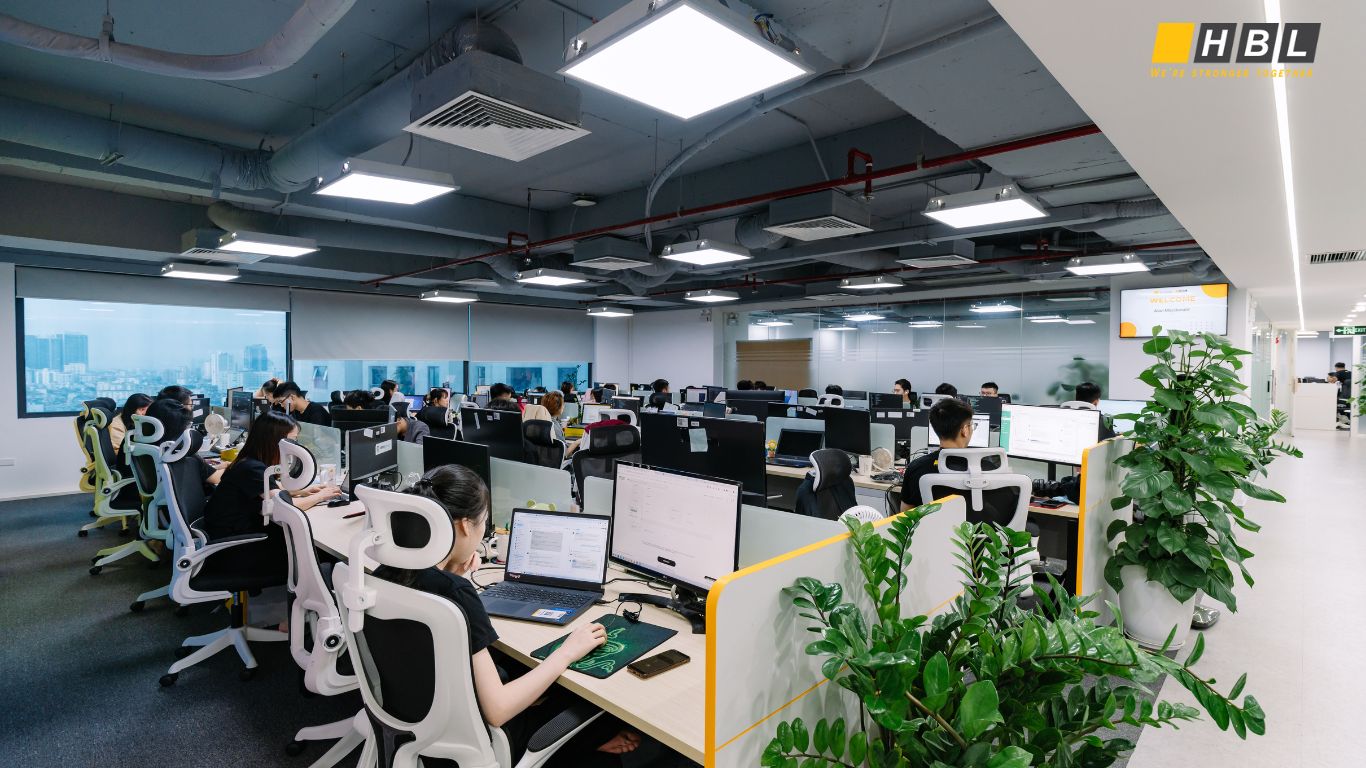
✅ Cost-Effective without Compromising Quality
By leveraging Vietnam’s competitive cost base, HBLAB delivers top-tier managed services at up to 30% lower cost compared to local providers in markets like Singapore, Australia, and the US — while maintaining international standards.
✅ Diverse Tech Stack & Multi-Platform Expertise
HBLAB covers full-cycle software development, infrastructure management, cloud services, DevOps, QA, cybersecurity, and more — across various platforms and technologies (Java, .NET, Node.js, React, AWS, Azure, etc.).
✅ Compliance and Security Excellence
The company follows rigorous security protocols and is certified at CMMI Level 3, a mark of its mature and well-managed processes.
Client Testimonial Highlight
“HBLAB’s communication was outstanding. HBLAB team is very good at understanding a complicated process very quickly and then simplifying them. We are really impressed with HBLAB’s AI department, they are highly skilled and the project management is also excellent.”
Read more: Telemax’s testimonial on working with HBLAB
Whether you’re a startup needing agile support or a multinational seeking enterprise-grade scalability, HBLAB delivers managed IT services that combine global quality with Vietnamese agility.
👉 Contact HBLAB today to explore how their tailored Managed IT Services can help optimize your operations and fuel your growth
Use Cases and Industries Benefiting from Managed IT Services
Managed IT Services are not a one-size-fits-all solution. Instead, they provide tailored support across a wide variety of industries and business scenarios. Here’s how different sectors benefit from partnering with Managed Services Providers (MSPs):
🏥 Healthcare
- HIPAA compliance and patient data protection
- 24/7 system monitoring for critical healthcare applications
- Secure telemedicine platforms and electronic health record (EHR) support
- Backup and disaster recovery for clinical data
💳 Finance and FinTech
- PCI-DSS compliance and secure transaction systems
- Real-time fraud detection and risk management
- Infrastructure for online banking and digital wallets
- Cloud migration and scalable hosting for financial platforms
🛍️ Retail and E-commerce
- Cloud-based POS systems and inventory management
- Omnichannel integration (online, in-store, mobile)
- Cybersecurity protection against data breaches and fraud
- Scalability to handle seasonal spikes in traffic and transactions

🏭 Manufacturing and Logistics
- IT support for ERP, MES, and SCADA systems
- Predictive maintenance using IoT-enabled infrastructure
- Workflow automation and process digitization
- Secure supply chain data sharing and analytics
🎓 Education and EdTech
- Deployment and maintenance of e-learning platforms (LMS)
- Secure access to digital resources for students and staff
- Real-time tech support for remote/hybrid learning
- Compliance with data protection for minors (e.g., FERPA)
🏢 Professional Services (Consulting, Legal, Accounting)
- Centralized document management systems
- Secure client communications and data storage
- Virtual desktop infrastructure (VDI) for remote professionals
- Compliance with legal and industry-specific regulations
🧪 Startups and Tech Companies
- Scalable cloud infrastructure for MVPs and product launches
- DevOps and CI/CD pipeline management
- 24/7 monitoring to support global users
- Managed security operations center (SOC) as a service
These real-world applications show how Managed IT Services help organizations reduce risk, control costs, improve performance, and stay focused on their core competencies — regardless of industry
Future Trends in Managed IT Services
As technology evolves, the Managed IT Services landscape continues to adapt to new challenges, innovations, and business demands. Here are the top trends that are shaping the future of Managed IT Services globally — and how Vietnam-based providers like HBLAB are positioning themselves to stay ahead:
1. AI and Automation in IT Operations (AIOps)
AI-powered tools are increasingly used for proactive system monitoring, anomaly detection, predictive maintenance, and self-healing capabilities — reducing human intervention and minimizing downtime.
2. Cloud-Native and Multi-Cloud Environments
Enterprises are moving from legacy systems to cloud-native architectures. MSPs are now expected to manage multi-cloud strategies involving AWS, Azure, GCP, and private clouds — optimizing cost, performance, and redundancy.
3. Zero Trust Security Frameworks
With more businesses supporting remote and hybrid work, Zero Trust models — which assume no user or system is trustworthy by default — are becoming the standard. MSPs must provide end-to-end identity, device, and data protection.
4. Cybersecurity-as-a-Service (CSaaS)
Security is now a key value proposition of MSPs. Expect to see growth in services like managed SOCs, endpoint detection and response (EDR), SIEM integration, penetration testing, and compliance-as-a-service.
5. Edge Computing Integration
As IoT devices and remote offices proliferate, there’s a rising demand for managing IT operations closer to the source — at the edge. MSPs will play a key role in deploying and maintaining distributed infrastructure.
6. Sustainability and Green IT
Environmental responsibility is becoming a business priority. Managed service providers are helping clients reduce energy use, optimize data center efficiency, and adopt sustainable IT practices.
7. Business Intelligence and Advanced Analytics
MSPs are extending their role beyond support to strategic enablement — offering analytics platforms, dashboards, and insights that help businesses make data-driven decisions.
8. Customized and Industry-Specific Solutions
As client demands become more nuanced, MSPs are expected to offer verticalized solutions tailored to specific industries such as healthcare, finance, retail, and manufacturing.
By aligning with these trends, managed service providers ensure long-term value for their clients — and help them navigate the complexities of digital transformation with confidence.
Final Thoughts
Managed IT Services offer immense value to companies looking to scale efficiently while maintaining a strong IT backbone. Vietnam, led by providers like HBLAB, offers a strategic advantage through a talented workforce, cost savings, and global-standard services.
If you’re ready to optimize your IT infrastructure and operations, consider Vietnam as your destination — and HBLAB as your trusted managed IT services partner.
Read more:
Team Augmentation in Software Development: A Complete Guide to Building Agile, Scalable Teams
